Serial Laboratory Effective Thermal Conductivity Measurements of Cohesive and Non-cohesive Soils for the Purpose of Shallow Geothermal Potential Mapping and Databases—Methodology and Testing Procedure Recommendations
Abstract
1. Introduction
- A total of 308,120 boreholes located in areas of the Engineering–Geological Atlases (16 Polish urban agglomeration areas);
- A total of 19,860 boreholes all over the country (outside the Atlases area), introduced from the geological and geotechnical reports created since 2013;
- Over 76,020 boreholes from Warsaw in the form of Geotechnical Excavation Cards.
- A total of 65,834 physical and mechanical parameters of soils;
- A total of 100 physical and mechanical parameters of rocks [21].
2. Materials and Methods
2.1. Measurement Theoretical Background
2.2. Measuring Equipment
2.3. Auxiliary Equipment
- Stainless steel cylinder with a tapping fork that is used to determine non-cohesive soil bulk density was utilized to form sand samples for thermal conductivity analyses;
- Metal form with a rammer, that were utilized for molding cohesive soil samples;
- Knife with a straight edge was used to even samples surface to the level of upper edge of the mold;
- Laboratory thermometer to monitor environment temperature during measurements.
2.4. Samples Used in the Testing Procedure
- -
- determination of water content,
- -
- determination of particle size distribution,
- -
- determination of bulk density for cohesive soils and relative density for non-cohesive soils,
- -
- determination of liquid and plastic limits.
2.5. Sample Preparation
2.6. Preparation of Cohesive Soil Samples
2.6.1. Samples with Natural Water Content
2.6.2. Dry Samples
2.7. Preparation of Non-cohesive Soil Samples
2.7.1. Samples with Natural Water Content
2.7.2. Dry Samples
2.7.3. Samples Fully Saturated with Water
2.8. Thermal Conductivity Test Procedure
Verification of the Results
3. Results
- Water content was measured according to EN ISO 17892-1:2014, Geotechnical investigation and testing—Laboratory testing of soil—Part 1: Determination of water content [17].
- Bulk density was measured according to EN ISO 17892-2:2014, Geotechnical investigation and testing—Laboratory testing of soil—Part 2: Determination of bulk density [13].
- Particle size distribution was measured according to EN ISO 17892-4:2017 Geotechnical investigation and testing—Laboratory testing of soil—Part 4: Determination of particle size distribution [14].
- Determination of soil’s consistency was based on methodology according to EN ISO 17892-12:2018 Geotechnical investigation and testing—Laboratory testing of soil—Part 12: Determination of liquid and plastic limits [15].
- Description and classification of soil was done according to ISO 14688-1:2017 Geotechnical investigation and testing—Identification and classification of soil—Part 1 and 2 [16].
3.1. Non-cohesive Soils
3.2. Cohesive Soils
4. Discussion
5. Conclusions
Author Contributions
Funding
Conflicts of Interest
References
- Florides, G.A.; Pouloupatis, P.D.; Kalogirou, S.; Messaritis, V.; Panayides, I.; Zomeni, Z.; Partasides, G.; Lizides, A.; Sophocleous, E.; Koutsoumpas, K. The geothermal characteristics of the ground and the potential of using ground coupled heat pumps in Cyprus. Energy 2011, 36, 5027–5036. [Google Scholar] [CrossRef]
- Ramos, R.; Aresti, L.; Christodoulides, P.; Vieira, A.; Florides, G. Assessment and Comparison of Soil Thermal Characteristics by Laboratory Measurements. In Energy Geotechnics. SEG 2018; Springer Series in Geomechanics and Geoengineering; Ferrari, A., Laloui, L., Eds.; Springer: Cham, Switzerland, 2018; pp. 155–162. Available online: https://link.springer.com/chapter/10.1007/978-3-319-99670-7_20 (accessed on 16 January 2019).
- Vieira, A.; Alberdi-Pagola, M.; Christodoulides, P.; Javed, S.; Loveridge, F.; Nguyen, F.; Cecinato, F.; Maranha, J.; Florides, G.; Prodan, J.; et al. Characterisation of Ground Thermal and Thermo-Mechanical Behaviour for Shallow Geothermal Energy Applications. Energies 2017, 10, 2044. [Google Scholar] [CrossRef]
- Ryżyński, G.; Bogusz, W. City-scale perspective for thermoactive structures in Warsaw. Environ. Geotech. 2016, 3, 280–290. [Google Scholar] [CrossRef]
- Bogusz, W. Możliwość zastosowania fundamentów termoaktywnych w budownictwie mostowym. Mosty 2017, 1, 42–45. (In Polish) [Google Scholar]
- Baralis, M.; Barla, M.; Bogusz, W.; Di Donna, A.; Ryżyński, G.; Żeruń, M. Geothermal potential of the NE extension Warsaw (Poland) metro tunnels. Environ. Geotech. 2018, 1–13. Available online: https://www.icevirtuallibrary.com/doi/abs/10.1680/jenge.18.00042 (accessed on 16 January 2019). [CrossRef]
- Anders, G.J.; Radhakrishna, H.S. Power cable thermal analysis with consideration of heat and moisture transfer in the soil. IEEE Trans. Power Deliv. 1988, 3, 1280–1288. [Google Scholar] [CrossRef]
- Popov, Y.; Beardsmore, G.; Clauser, C.; Roy, S. ISRM suggested methods for determining thermal properties of rocks from laboratory tests at atmospheric pressure. Rock Mech. Rock Eng. 2016, 49, 4179–4207. [Google Scholar] [CrossRef]
- Ryżyński, G.; Łukawska, A.; Żeruń, M. Wytyczne do prowadzenia seryjnych oznaczeń laboratoryjnych przewodności cieplnej gruntów spoistych i niespoistych na potrzeby sporządzania map i baz danych potencjału geotermii niskotemperaturowej. Tech. Poszuk. Geol. Geoterm. Zrównoważony Rozw. 2018, 57, 229–230. (In Polish) [Google Scholar]
- EN 1997-2:2007 Eurocode 7: Geotechnical Design—Part 2: Ground Investigation and Testing; European Committee for Standardization: Brussels, Belgium, 2007; Available online: https://eurocodes.jrc.ec.europa.eu/showpage.php?id=137 (accessed on 5 December 2019).
- ASTM. ASTM D698-12e2, Standard Test Methods for Laboratory Compaction Characteristics of Soil Using Standard Effort (12 400 ft-lbf/ft3 (600 kN-m/m3)); ASTM International: West Conshohocken, PA, USA, 2012. [Google Scholar]
- ISO. ISO 14688-2:2018 Geotechnical Investigation and Testing. Identification and Classification of Soil. Principles for a Classification; International Organization for Standardization: Geneva, Switzerland, 2018; Available online: https://www.iso.org/ (accessed on 25 December 2019).
- ISO. ISO 17892-2:2014 Geotechnical Investigation and Testing. Laboratory Testing of Soil. Determination of Bulk Density; International Organization for Standardization: Geneva, Switzerland, 2014; Available online: https://www.iso.org/ (accessed on 10 December 2019).
- ISO. ISO 17892-4:2017 Geotechnical Investigation and Testing—Laboratory Testing of Soil—Part 4: Determination of Particle Size Distribution; International Organization for Standardization: Geneva, Switzerland, 2017; Available online: https://www.iso.org/ (accessed on 10 November 2019).
- ISO. ISO 17892-12:2018 Geotechnical Investigation and Testing—Laboratory Testing of Soil—Part 12: Determination of Liquid and Plastic Limits; International Organization for Standardization: Geneva, Switzerland, 2018; Available online: https://www.iso.org/ (accessed on 18 November 2019).
- ISO. ISO 14688-1:2017 Geotechnical Investigation and Testing—Identification and Classification of Soil—Part 1: Identification and Description; International Organization for Standardization: Geneva, Switzerland, 2017; Available online: https://www.iso.org/ (accessed on 21 November 2019).
- ISO. ISO 17892-1:2014 Geotechnical Investigation and Testing. Laboratory Testing of Soil. Determination of Water Content; International Organization for Standardization: Geneva, Switzerland, 2014; Available online: https://www.iso.org/ (accessed on 5 December 2019).
- PN-B-04481:1988 Grunty Budowlane—Badania Próbek Gruntu (Geotechnical Soils—Soil Testing); The Polish Committee for Standardization: Warszawa, Polska, 1988; Available online: https://www.pkn.pl/en/ (accessed on 9 December 2019). (In Polish)
- ASTM. ASTM D5334-14 Standard Test Method for Determination of Thermal Conductivity of Soil and Soft Rock by Thermal Needle Probe Procedure; ASTM International: West Conshohocken, PA, USA, 2014. [Google Scholar]
- IEEE. IEEE 442-2017—IEEE Guide for Thermal Resistivity Measurements of Soils and Backfill Materials; The Institute of Electrical and Electronics Engineers: New York, NY, USA, 2017; Available online: https://www.ieee.org/ (accessed on 12 November 2019).
- Baza Danych Geologiczno-Inżynierskich BDGI. Available online: http://geoportal.pgi.gov.pl/atlasy_gi (accessed on 23 December 2019). (In Polish)
- Frankowski, Z.; Majer, E.; Sokołowska, M.; Ryżyński, G.; Ostrowski, S.; Majer, K. Badania geologiczno-inżynierskie prowadzone w Państwowym Instytucie Geologicznym w drugim pięćdziesięcioleciu jego działalności. Prz. Geol. 2018, 66, 752–768. (In Polish) [Google Scholar]
- Majer, E.; Sokołowska, M.; Frankowski, Z.; Barański, M.; Bestyński, Z.; Ostrowski, S.; Pasieczna, A.; Pietrzykowski, P.; Przyłucka, M.; Błachnio, O.; et al. Zasady Dokumentowania Geologiczno-Inżynierskiego; Dział Wydawnictw PIG-PIB: Warsaw, Poland, 2018; pp. 34–35. (In Polish)
- Ryżyński, G.; Żeruń, M.; Kocyła, J.; Kłonowski, M.R. Estimation of Potential Low-temperature Geothermal Energy Extraction from the Closed-loop Systems Based on Analysis, Interpretation and Reclassification of Geological Borehole Data in Poland. In Proceedings of the World Geothermal Congress 2020, Reykjavik, Iceland, 26 April—2 May 2020. [Google Scholar]
- Farouki, O.T. Thermal Properties of Soils; Cold Regions Research and Engineering Laboratory Monograph 81-1: New Hampshire, MA, USA, 1981. [Google Scholar]
- Robertson, E.C. Thermal Properties of Rocks; Open-File Report no. 88-441; US Geological Survey: Richmond, VA, USA, 1988. Available online: https://pubs.er.usgs.gov/publication/ofr88441 (accessed on 12 January 2019).
- Maglić, K.D.; Cezairliyan, A.; Peletsky, V.E. (Eds.) Compendium of Thermophysical Property Measurement Methods: Volume 2 Recommended Measurement Techniques and Practices; Springer: Boston, MA, USA, 1992. [Google Scholar]
- Carslaw, H.S.; Jaeger, J.C. Conduction of Heat in Solids; Oxford Science Publications: Oxford, UK, 1959. [Google Scholar]
- KD2 Pro Thermal Properties Analyzer Operator’s Manual Version 4; Decagon Devices: Pullman, DC, USA, 2016; Available online: https://www.metergroup.com/ (accessed on 18 January 2019).
- Myślińska, E. Laboratoryjne Badania Gruntów; Wydawnictwo Naukowe PWN: Warsaw, Poland, 2006. (In Polish) [Google Scholar]
- Thermophysical Instruments—Geothermal Investigation TK04 Thermal Conductivity Meter User’s Manual version 5.5; Thermophysical Instruments—Geothermal Investigation: Berlin, Germany, 2019; Available online: https://www.te-ka.de/en/ (accessed on 16 January 2019).
- Polska Organizacja Rozwoju Technologii Pomp Ciepła. Wytyczne Projektowania, Wykonania i Odbioru Instalacji z Pompami Ciepła. Część 1—Dolne źródło Ciepła; Wydanie 1: Krakow, Poland, 2013. (In Polish) [Google Scholar]
- VDI 4640 Blatt 2 2001 Thermal use of the underground—Ground source heat pump systems. 2001.
- Bolcon Sweden. EED 3.0-Earth Energy Designer; Bolcon AB: Lund, Sweden, 2008; Available online: https://buildingphysics.com (accessed on 29 November 2019).
- Santaa, G.D.; Galgaroa, A.; Sassia, R.; Cultreraa, M.; Scottona, P.; Muellerc, J.; Bertermannc, D.; Mendrinosd, D.; Pasqualie, R.; Peregoa, R.; et al. An updated ground thermal properties database for GSHP applications. Geothermics 2020, 85, 101758. [Google Scholar] [CrossRef]
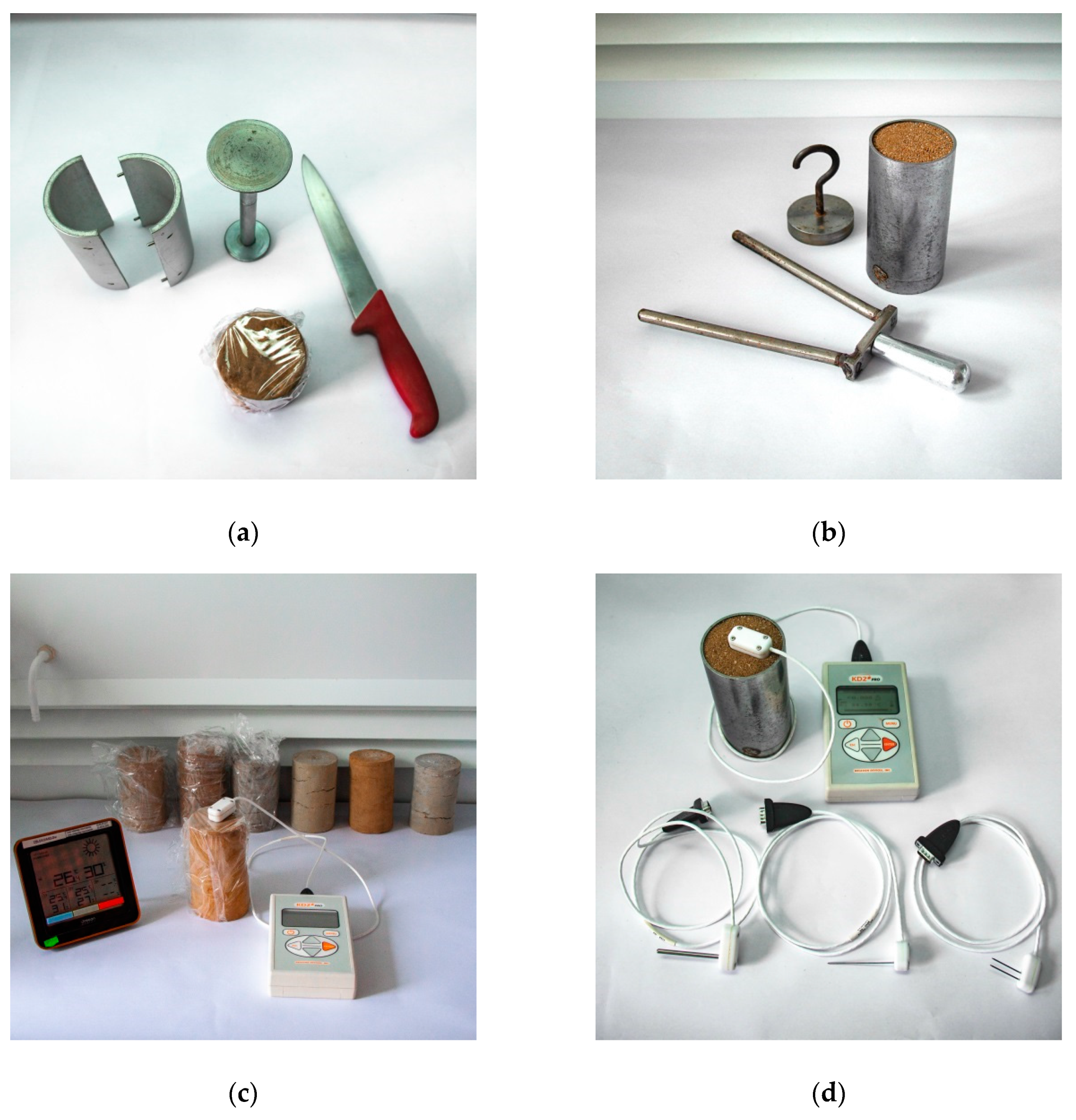
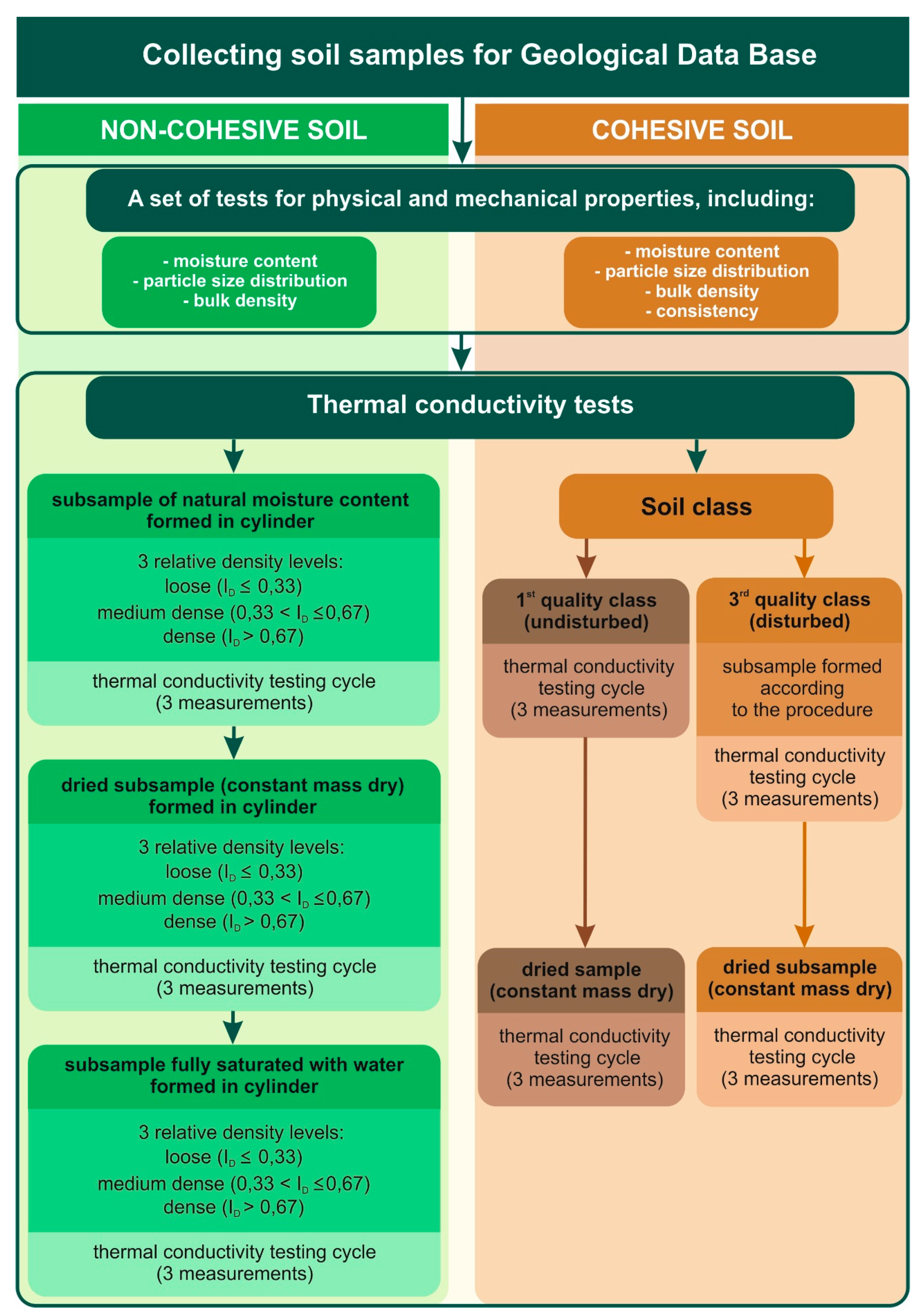
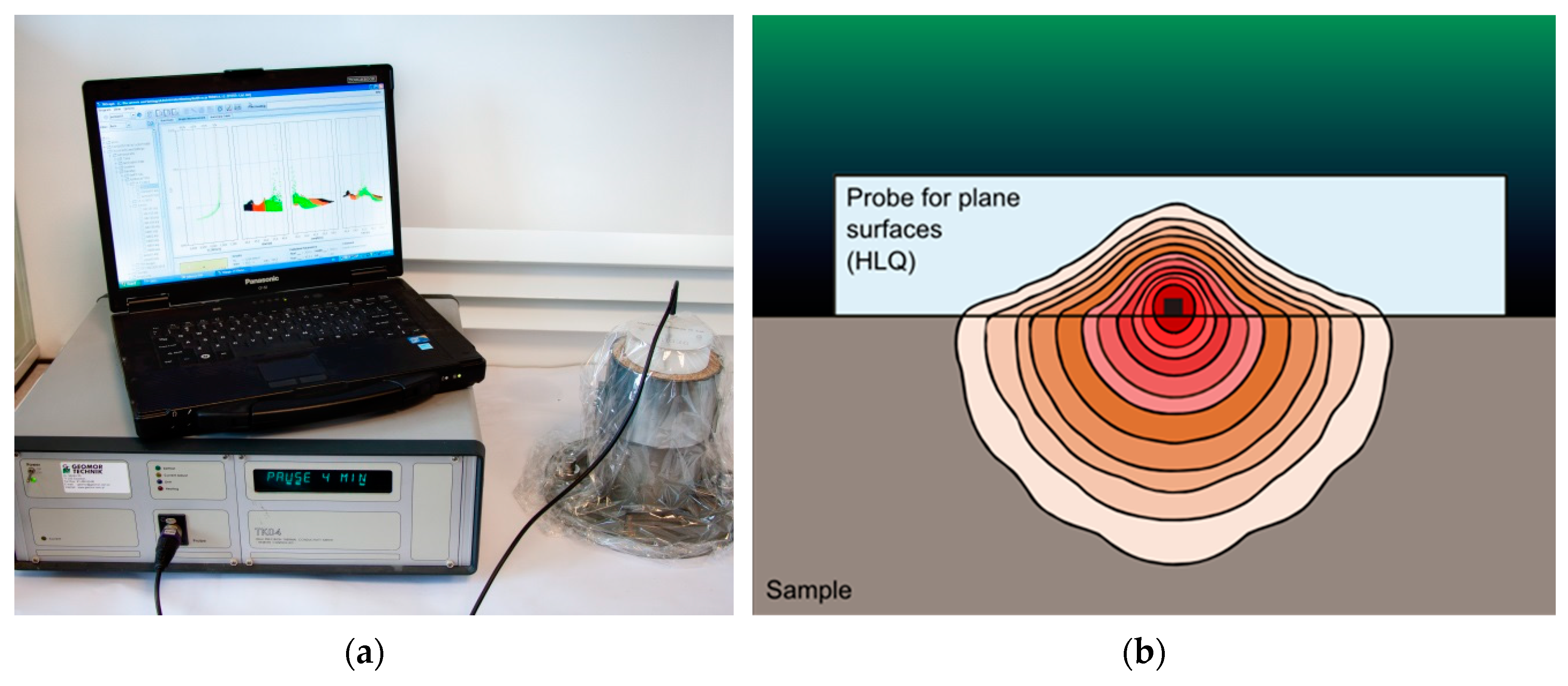
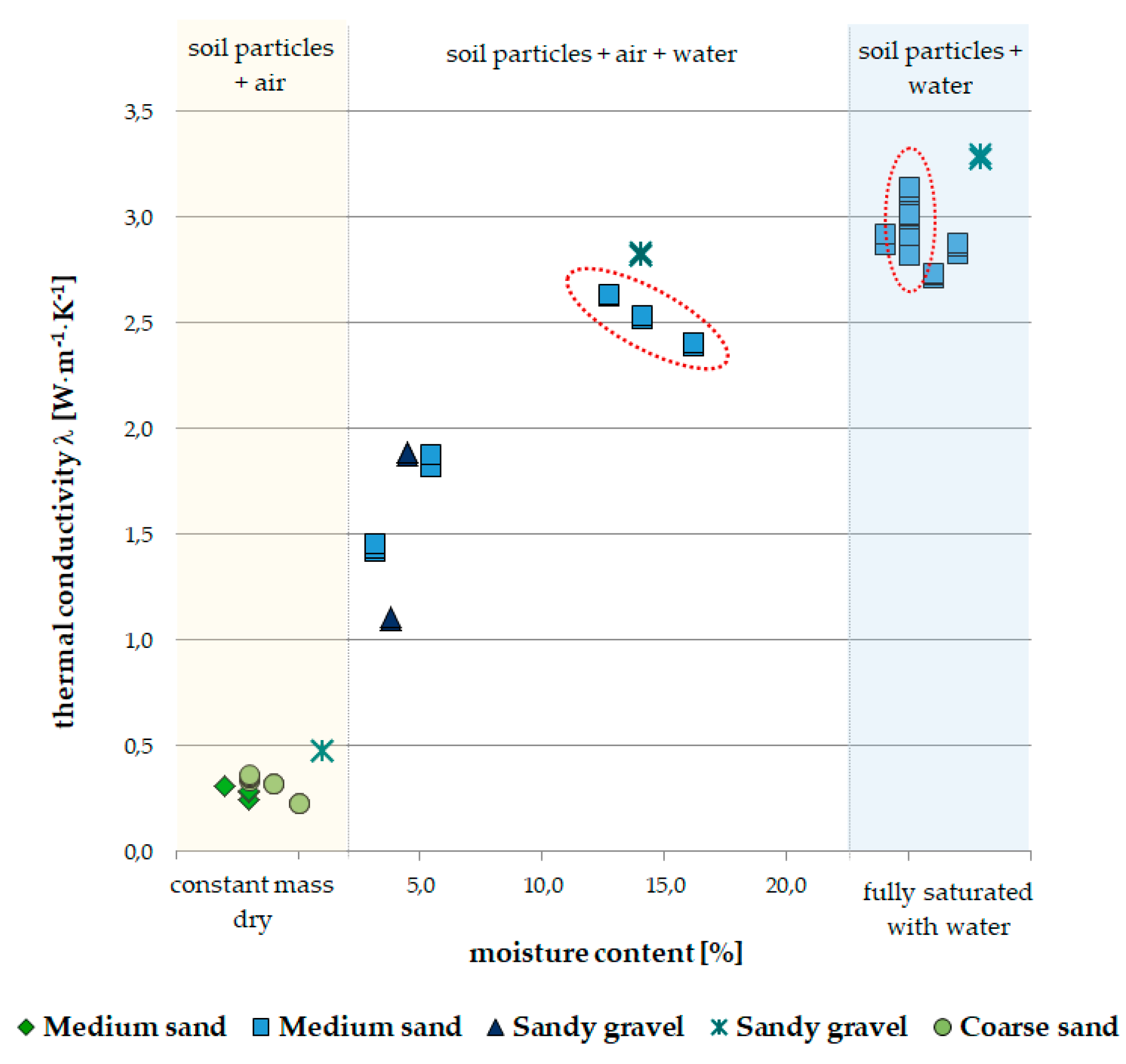
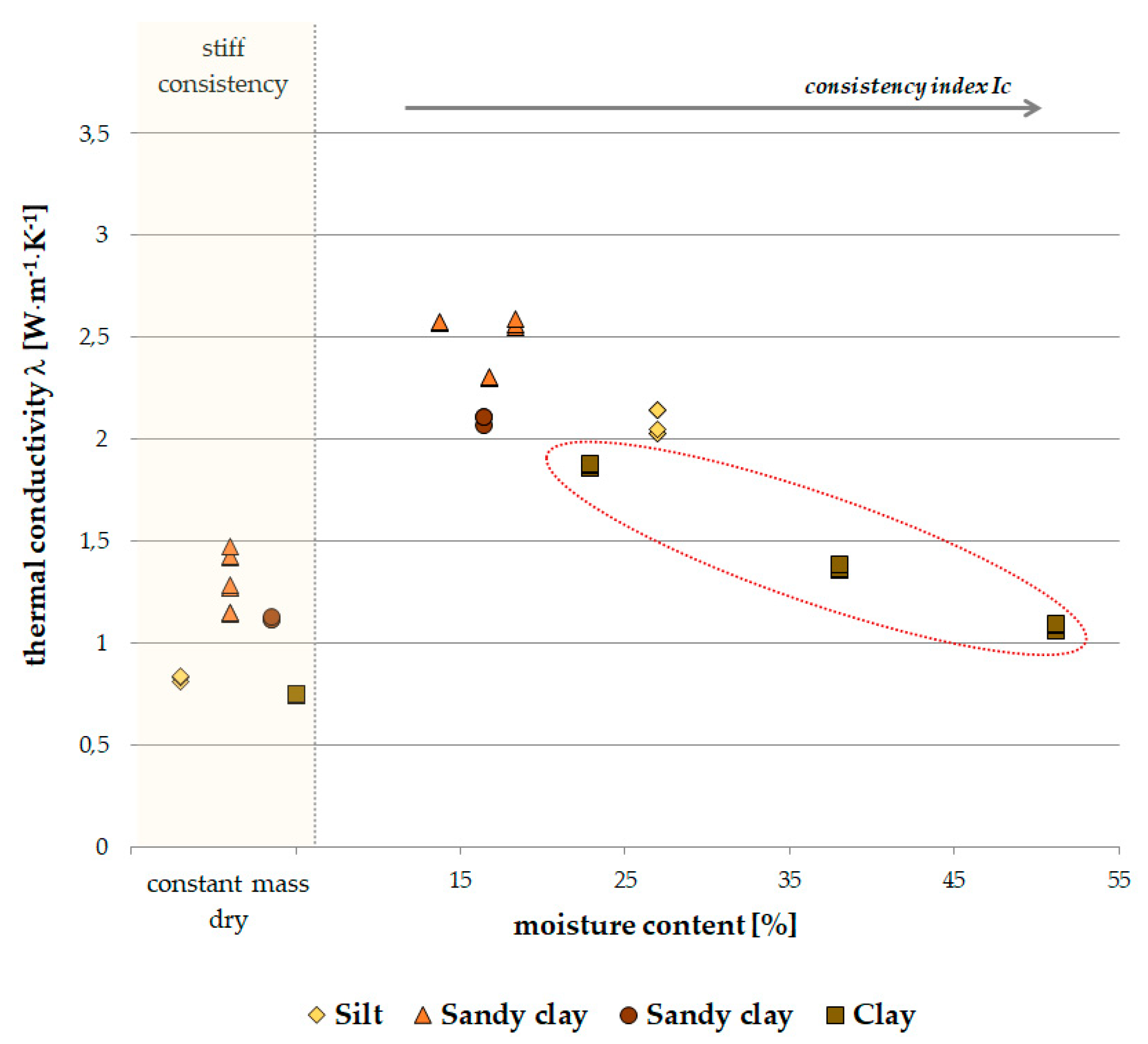
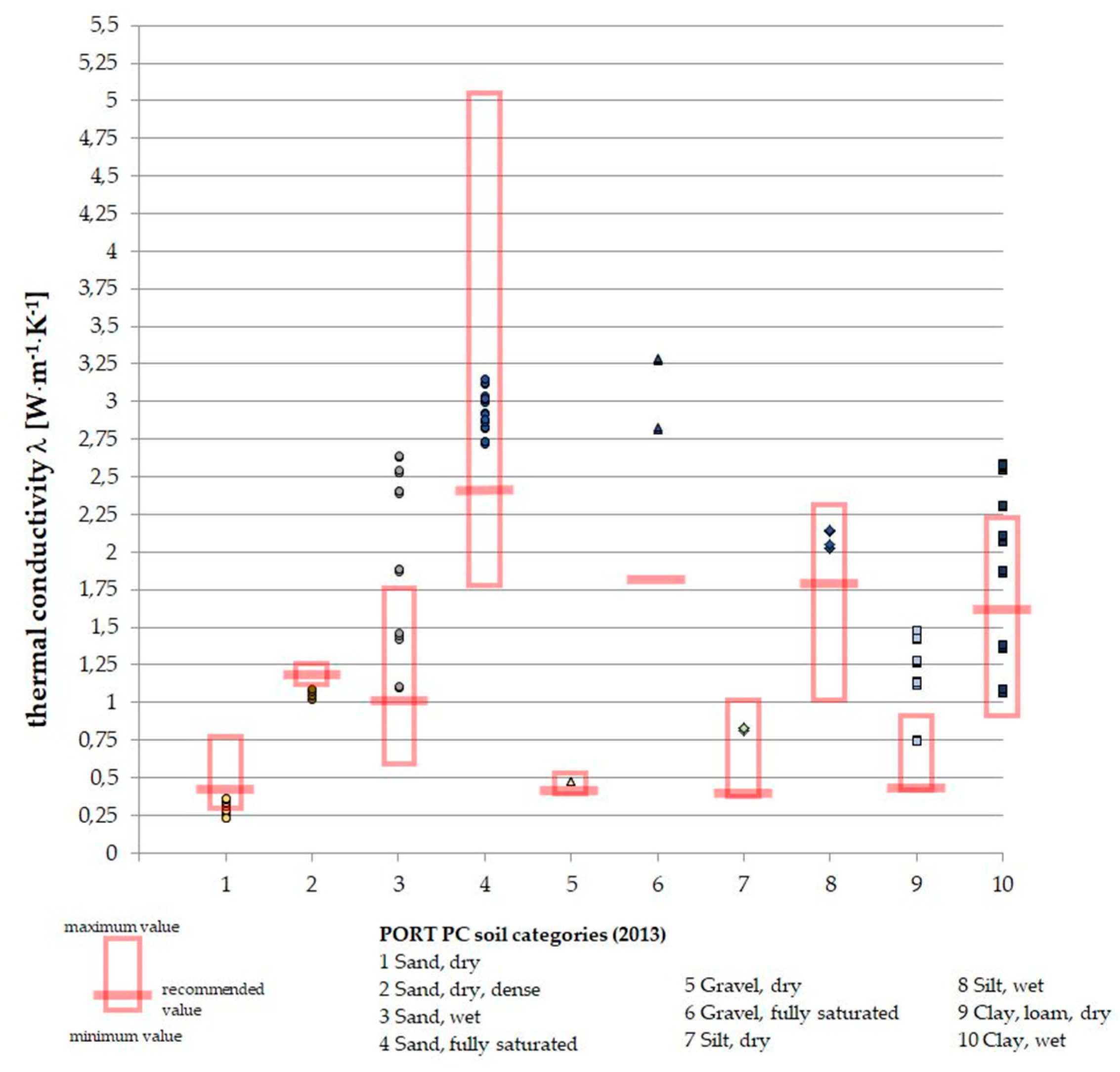
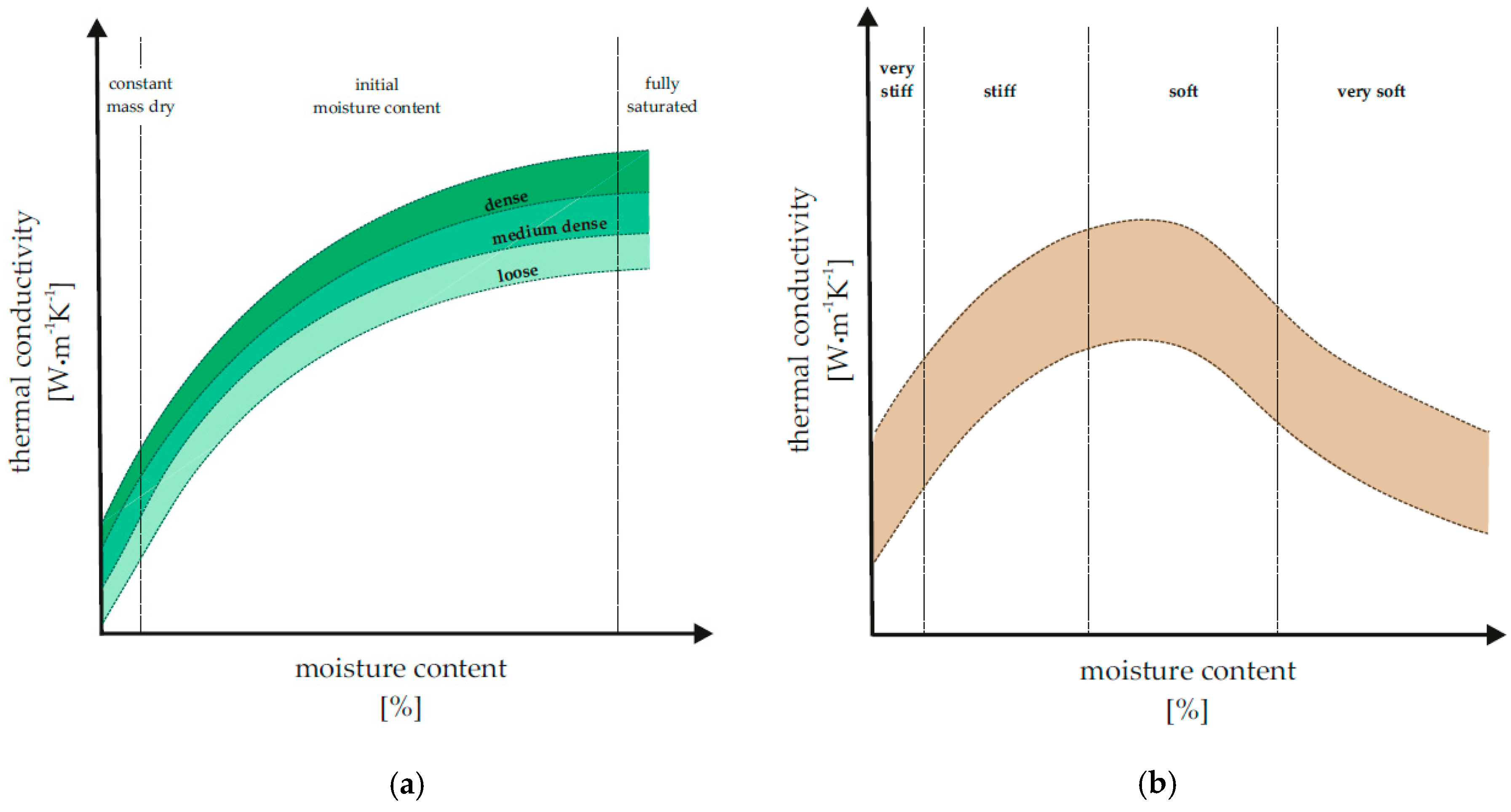
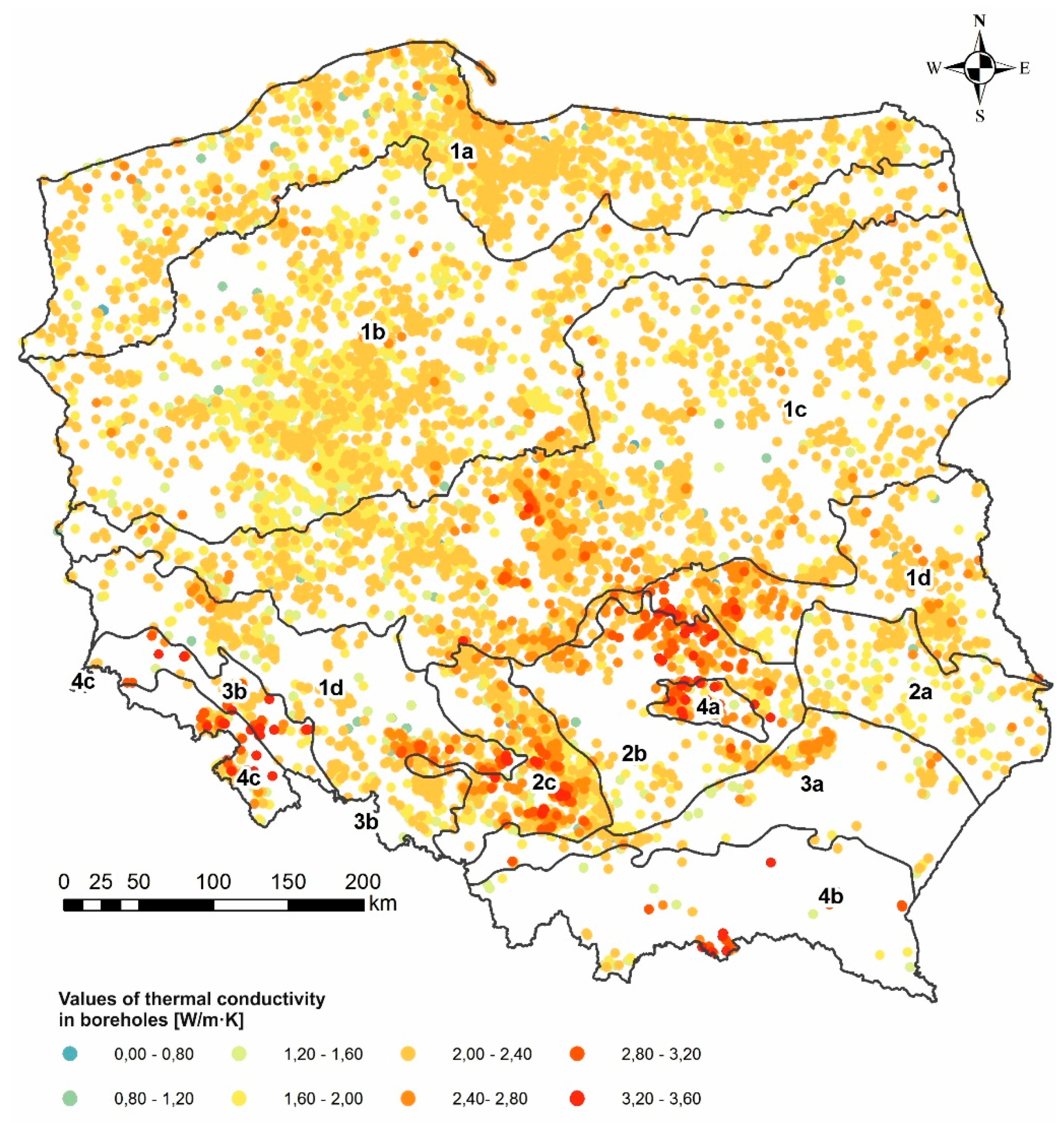
| Sample no | Soil Type | Particle Size Distribution [%] | Water Content | Relative Density | Bulk Density [g/cm3] | Thermal Conductivity λ [W/(m*K)] | PORT PC Category | ||
|---|---|---|---|---|---|---|---|---|---|
| >2 mm | >0.5 mm | >0.25 mm | |||||||
| PNS-11 | Sand gravel | 12.09 | 64.69 | 83.47 | dry | dense | 1.89 | 0.473 0.474 0.475 | 2 |
| natural water content | dense | 1.97 | 2.814 2.817 2.834 | 3 | |||||
| fully saturated | dense | 2.22 | 3.227 3.270 3.293 | 4 | |||||
| dry (validation) | dense | 1.91 | 1.050 1.075 1.087 | 2 | |||||
| PNS-2 | Medium sand | 0.16 | 5.23 | 57.39 | dry | loose | 1.55 | 0.246 0.246 0.246 | 1 |
| medium dense | 1.70 | 0.279 0.280 0.286 | 1 | ||||||
| dense | 1.85 | 0.335 0.350 0.351 | 2 | ||||||
| natural water content | loose | 1.79 | 2.392 2.406 2.407 | 3 | |||||
| medium dense | 1.83 | 2.523 2.541 2.542 | 3 | ||||||
| dense | 1.87 | 2.630 2.634 2.640 | 3 | ||||||
| fully saturated | loose | 1.84 | 2.822 2.826 2.827 | 4 | |||||
| medium dense | 2.05 | 2.920 3.013 3.038 | 4 | ||||||
| dense | 2.16 | 3.112 3.122 3.147 | 4 | ||||||
| PNS-3 | Coarse sand | 1.09 | 97.45 | 99.58 | dry | dense | 1.82 | 0.324 0.324 0.325 | 2 |
| natural water content | dense | 1.87 | 1.871 1.886 1.888 | 3 | |||||
| fully saturated | dense | 1.98 | 2.732 2.739 2.715 | 4 | |||||
| PNS-41 | Gravel | 86.11 | 95.08 | 95.81 | dry | dense | 1.68 | 0.229 0.232 0.234 | 5 |
| natural water content | dense | 1.73 | 1.878 1.826 1.827 | 5 | |||||
| fully saturated | dense | 2.12 | 2.831 2.866 2.878 | 6 | |||||
| PNS-5 | Medium sand | 0.03 | 7.33 | 55.91 | dry | dense | 1.71 | 0.364 0.363 0.363 | 2 |
| natural water content | dense | 1.85 | 1.421 1.441 1.459 | 3 | |||||
| fully saturated | dense | 2.15 | 2.996 3.019 3.010 | 4 | |||||
| PNS-6 | Fine sand | 0.03 | 0.93 | 28.98 | dry | dense | 1.75 | 0.307 0.307 0.310 | 1 |
| natural water content | dense | 1.81 | 1.096 1.096 1.109 | 3 | |||||
| fully saturated | dense | 1.97 | 2.875 2.875 2.927 | 4 | |||||
| Sample no | Soil Type | Particle Size Distribution [%] | Water Content [%] | Subsample Type | Consistency | Bulk Density [g/cm3] | Thermal Conductivity λ [W/(m*K)] | PORT PC Category | |||
|---|---|---|---|---|---|---|---|---|---|---|---|
| >2 mm | 2–0.5 mm | 0.05–0.002 mm | <0.002 mm | ||||||||
| PS-1 | Silt | 0.00 | 29.89 | 60.33 | 9.78 | <2 | molded, dry | very stiff | 1.79 | 0.809 0.828 0.833 | 7 |
| 27.00 | molded, natural water content | firm | 2.11 | 2.139 2.141 2.143 | 8 | ||||||
| natural structure | firm | 2.16 | 2.027 2.028 2.050 | 8 | |||||||
| PS-2 | Sandy clay | 0.19 | 65.42 | 16.76 | 17.63 | <2 | molded, dry | very stiff | 1.93 | 1.141 1.145 1.145 | 9 |
| 18.34 | molded, natural water content | stiff | 2.15 | 2.547 2.564 2.586 | 10 | ||||||
| PS-3 | Sandy clay | 0.46 | 58.48 | 21.28 | 19.78 | <2 | molded, dry | very stiff | 2.01 | 1.421 1.423 1.475 | 9 |
| 13.74 | molded, natural water content | very stiff | 2.18 | 2.566 2.571 2.578 | 10 | ||||||
| PS-4 | Sandy clay | 0.21 | 56.35 | 25.24 | 18.2 | <2 | molded, dry | very stiff | 1.97 | 1.266 1.270 1.283 | 9 |
| 16.76 | molded, natural water content | stiff | 2.12 | 2.298 2.298 2.308 | 10 | ||||||
| PS-5 | Sandy clay | 0.68 | 36.3 | 43.23 | 19.7 | <2 | molded, dry | very stiff | 1.98 | 1.112 1.117 1.129 | 9 |
| 16.37 | molded, natural water content | stiff | 2.11 | 2.065 2.107 2.111 | 10 | ||||||
| PS-6 | Clay | 1.65 | 18.43 | 33.56 | 46.36 | <2 | molded, dry | very stiff | 1.71 | 0.744 0.749 0.746 | 9 |
| 22.86 | molded, natural water content | stiff | 2.1 | 1.861 1.875 1.880 | 10 | ||||||
| 37.98 | remolded, water added | soft | 1.9 | 1.359 1.367 1.382 | 10 | ||||||
| 51.21 | remolded, water added | very soft | 1.72 | 1.061 1.089 1.061 | 10 | ||||||
© 2020 by the authors. Licensee MDPI, Basel, Switzerland. This article is an open access article distributed under the terms and conditions of the Creative Commons Attribution (CC BY) license (http://creativecommons.org/licenses/by/4.0/).
Share and Cite
Łukawska, A.; Ryżyński, G.; Żeruń, M. Serial Laboratory Effective Thermal Conductivity Measurements of Cohesive and Non-cohesive Soils for the Purpose of Shallow Geothermal Potential Mapping and Databases—Methodology and Testing Procedure Recommendations. Energies 2020, 13, 914. https://doi.org/10.3390/en13040914
Łukawska A, Ryżyński G, Żeruń M. Serial Laboratory Effective Thermal Conductivity Measurements of Cohesive and Non-cohesive Soils for the Purpose of Shallow Geothermal Potential Mapping and Databases—Methodology and Testing Procedure Recommendations. Energies. 2020; 13(4):914. https://doi.org/10.3390/en13040914
Chicago/Turabian StyleŁukawska, Aleksandra, Grzegorz Ryżyński, and Mateusz Żeruń. 2020. "Serial Laboratory Effective Thermal Conductivity Measurements of Cohesive and Non-cohesive Soils for the Purpose of Shallow Geothermal Potential Mapping and Databases—Methodology and Testing Procedure Recommendations" Energies 13, no. 4: 914. https://doi.org/10.3390/en13040914
APA StyleŁukawska, A., Ryżyński, G., & Żeruń, M. (2020). Serial Laboratory Effective Thermal Conductivity Measurements of Cohesive and Non-cohesive Soils for the Purpose of Shallow Geothermal Potential Mapping and Databases—Methodology and Testing Procedure Recommendations. Energies, 13(4), 914. https://doi.org/10.3390/en13040914





